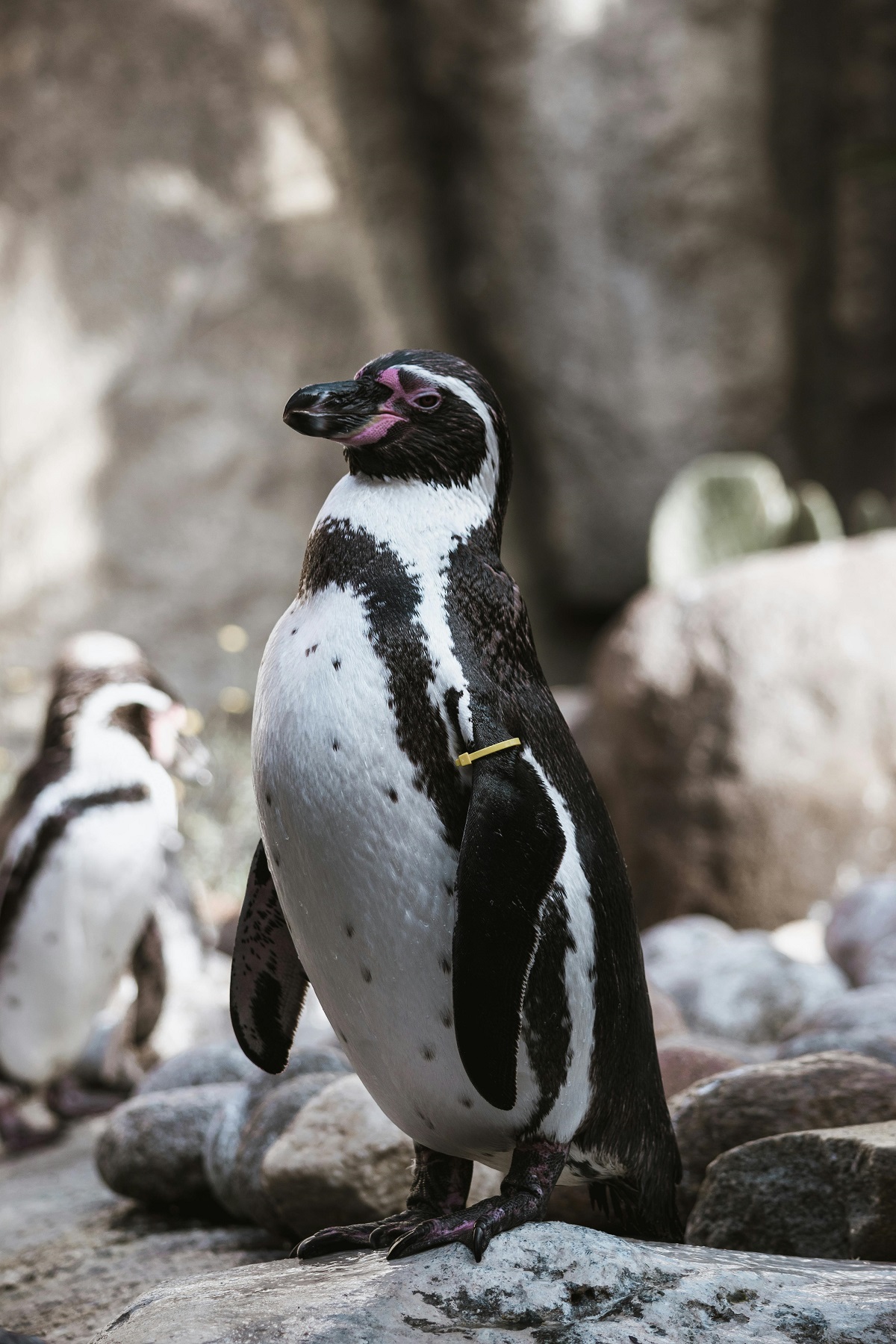Summary: The Humboldt Penguin (Spheniscus humboldti) is a medium-sized seabird native to the Pacific coasts of Peru and Chile. Recognizable by its black head, white border running from behind the eye to the throat, and two broad breast bands, it thrives in rocky coastal habitats. Feeding mostly on small fish like anchovies and sardines, Humboldt Penguins typically hunt in coastal waters. They nest in burrows or crevices, form strong breeding pairs, and undertake seasonal migrations. Classified as Vulnerable due to overfishing, habitat loss, and climate change, conservation efforts like protected reserves are vital for their survival.
The Humboldt penguin is a fascinating bird that lives along the coast of South America. Unlike other penguins, it prefers warmer climates. The Humboldt current flows in the Pacific Ocean, bringing cold water and rich nutrients to the penguin, which helps it find plenty of food.
Humboldt penguins are medium-sized. They grow up to 26 inches tall. They weigh between 8 to 13 pounds. Their black and white feathers help them blend in. This is called countershading. When swimming, predators from above see their dark backs. From below, their white bellies blend with the light.
Where Do Humboldt Penguins Live?

The Humboldt penguin lives along the western coast of South America. Its main habitat includes the rocky shores and islands of Chile and Peru. Unlike Antarctic penguins, it prefers warmer climates. However, the cold Humboldt Current keeps its environment cool.
These penguins nest in:
Rocky cliffs – They use crevices for shelter.
Coastal caves – They dig burrows or use natural hollows.
Guano (bird droppings) deposits – They sometimes nest in old guano layers.
The ocean near their habitat is rich in fish. This is because of the cold, nutrient-filled Humboldt Current. The current supports anchovies, sardines, and squid—their main food sources.
Why Is Their Habitat Special?
No ice or snow – They live in dry, coastal deserts.
Warm but cool waters – The current prevents extreme heat.
Isolated nesting spots – Protects them from predators.
What Do Humboldt Penguins Eat?
Humboldt penguins love fish. Their diet includes:
Anchovies
Sardines
Squid
Krill
They are excellent swimmers. They can dive up to 150 feet deep. Their wings work like flippers. This helps them move fast in water. They can swim up to 20 miles per hour.
Breeding and Family Life
Humboldt penguins mate for life. They return to the same nesting spot every year. The female lays one or two eggs. Both parents take turns keeping the eggs warm. After 40 days, the chicks hatch.
Baby penguins are covered in fluffy gray feathers. They stay in the nest for 10 to 12 weeks. Parents feed them regurgitated food. Once they grow strong, they learn to swim.
Interesting Facts About Humboldt Penguins
Named After a Current They’re called Humboldt penguins because they live near the Humboldt Current, a cold ocean flow along South America’s west coast.
Warm-Weather Penguins Unlike most penguins, they live in Chile and Peru, where temperatures are mild, not freezing.
Medium-Sized Birds They grow 22–28 inches (56–70 cm) tall and weigh 8–13 pounds (3.5–6 kg)—about the size of a small dog.
Black & White Camouflage – Their dark backs blend with the ocean when seen from above, and their white bellies match the sunlight from below (called countershading).
Fast Swimmers They can dive 150 feet (45 meters) deep and swim 20 mph (32 km/h) using their flipper-like wings.
Lifelong Mates They usually pair for life and return to the same nesting spot every year.
Loud Voices They communicate with braying calls, like a donkey’s “hee-haw” sound.
Molting Season Once a year, they lose old feathers and grow new ones, staying on land for 2–3 weeks without eating.
Endangered Species Only 10,000–12,000 remain in the wild due to overfishing, climate change, and habitat loss.
Zoo Stars Many zoos (like San Diego, London, and Berlin) breed them to help save the species.
Conclusion
The Humboldt penguin is a unique and special bird. It survives in a changing world. But it needs our help. By learning about them, we can take action. Small steps can save these amazing penguins. Let’s protect them for future generations.
Frequently Asked Questions
Where do Humboldt Penguins live?
Humboldt Penguins are found along the rocky Pacific coasts of Peru and Chile.
What do Humboldt Penguins eat?
They primarily eat small fish such as anchovies and sardines, caught on coastal dives.
How big do Humboldt Penguins get?
Adults reach about 26 inches (65 cm) in height and weigh between 7 to 11 pounds (3–5 kg).
How do they nest?
They nest in burrows, caves, or rock crevices and often return to the same site each breeding season.
Are Humboldt Penguins endangered?
They are listed as Vulnerable due to threats like overfishing, oil spills, habitat destruction, and climate change.
Do Humboldt Penguins migrate?
They make short coastal migrations in search of food but do not undertake long-distance migrations.
How long do Humboldt Penguins live?
In the wild, they typically live around 15–20 years; in captivity, they can reach up to 30 years.
What do Humboldt Penguins look like?
They have black heads, a white border from eye to throat, and two black breast bands on a white chest.
How do they breed?
They form monogamous pairs and usually lay two eggs per clutch, with both parents incubating and caring for the chicks.
What conservation efforts help them?
Protector reserves, regulated fishing quotas, and rescue centers help maintain and rebuild their populations.

